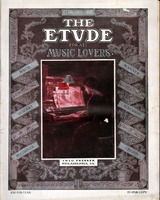The following brief quotation from a lengthy paper on singing, by A. Duvivier, gives a comprehensive idea of the technic of respirations. It states facts which every intelligent teacher of singing acknowledges; but especially illuminating is the emphasis with which three simple exercises in breathing are held as the most if not the only important ones.
So many exercises in breathing are given by teachers that their pupils fail because of a lack of concentration upon the few which are all that are needful.
RESPIRATION.
The two acts of inhaling and of exhaling constitute respiration. The art of correct breathing ought to be, from the very beginning, one of the most important objects of the student who aspires to become a skilful singer. The act of respiration is under the control of the midriff or diaphragm, a large, thin muscle closing the case of the chest cavity and separating the thorax from the abdomen.
In the first attempt to emit a sound, the diaphragm flattens itself, the stomach slightly protrudes and the breath is introduced at will by the nose, by the mouth, or by both simultaneously. During this partial inspiration, which is called abdominal, the ribs do not move, nor are the lungs filled to their full capacity, to obtain which the diaphragm must and does contract completely. Then, and only then, are the ribs raised, while the stomach is drawn in. This inspiration, in which the lungs have their free action from side to side, from front to back, from top to bottom, is complete, and is called thoracic or intercostal. If by compression of any kind the lower ribs are prevented from expanding, the breathing becomes sternal or clavicular. Of these three modes of breathing, the thoracic or intercostal is a correct one.
To improve respiration the best exercises recommended are:
“1. Draw a breath slowly through a very minute opening of the lips, then exhale freely.
“2. Breathe freely and exhale slowly through the same small opening.
“3. Breathe freely and retain the breath during ten seconds or more.”
Perform above mentioned exercises lying on a flat surface, with the head and shoulders on the same level as the body, which should be perfectly relaxed, placing one hand gently on the pit of the stomach and the other on the upper part of the sternum. This position will help, first, in preventing any raising of the shoulders; secondly, in realizing the correct action of the diaphragm, and, thirdly, in controlling any motion of the upper part of the chest, which must remain perfectly immobile. The flow of breath should be absolutely noiseless, the pressure of the diaphragm continuous, even and well managed.



